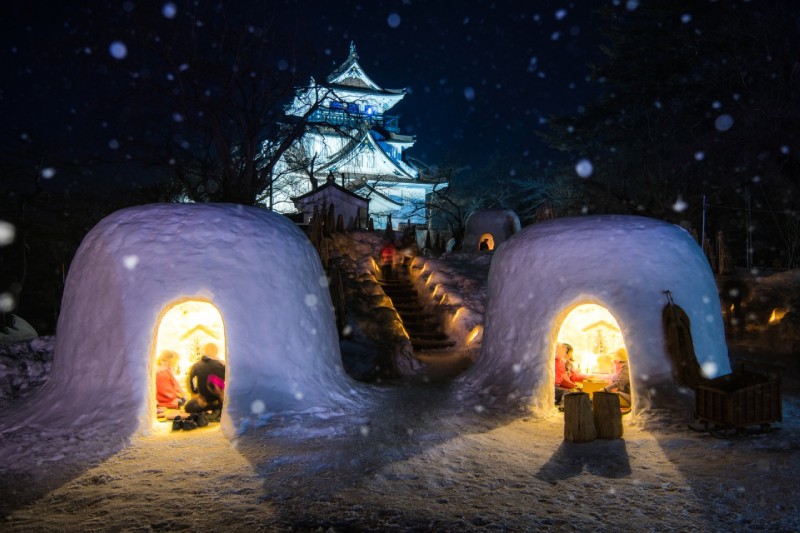Festivals & Events
Yokote Kamakura Festival: History and Significance of the Snow Festival

The Yokote Kamakura Festival is also known as Yokote no Yuki Matsuri (横手の雪まつり) with a history spanning approximately 450 years. Each year, on February 15 and 16, the city of Yokote in the southeast of Akita Prefecture hosts it. Known as Kamakura, the festival features a large number of these igloo-like snow houses that are constructed at different locations throughout the city.
One of the Michinoku Godai Snow Festivals (the five main snow festivals of Michinoku) is the Yokote Kamakura Festival. One of the places in Japan’s snow country with the most snowfall is Yokote. Every year on February 15 and 16, the water deity is honored at the Kamakura Festival. Altars are constructed in snow chambers for this folk festival, where children can play, and enjoy amazake, a sweet fermented rice drink, and grilled rice cakes. The celebration has been around for approximately 450 years.
Originally, the purpose of the Kamakura Festival was to pray for good harvests, business success, and family well-being by offering money to the water deity housed in the altar. But as times changed, it progressively evolved into a tourist destination and adopted its present design. Within the approximately 100 Kamakura snow huts situated throughout the city, children indulge in rice cakes and amazake.
The magical beauty of the Kamakura snow huts is their silhouettes against the pitch-black night. Walking among the Kamakura is highly recommended. The most populous location is the park in front of Yokote City Hall Main Government Office. From there, you can find much smaller Kamakura at Yokoteminami Elementary School and Janosaki-kawara. There are also Kamakura built along the old samurai residences, and finally, there are Kamakura at the illuminated Yokote Castle.
Every Kamakura has a snow altar honoring the water deity, to whom people offer prayers for an abundance of water. To grill rice cakes and provide warmth, a charcoal brazier is set up. Children welcome festival goers into their Kamakura in the evenings (18:00 to 21:00) and serve them rice cakes and amazake, a warm sweet rice wine with little to no alcohol. The guests give an offering to the altar’s water deity in exchange.
Stretching eastward from Yokote Station to Yokote Castle, situated approximately two kilometers distant across the Yokote River, is the festival area. Beginning at the station, tourists can take a stroll through the town’s streets and take in views of Kamakura constructed next to nearby homes. Participation in Kamakura making is also possible during one of Komyoji Park’s interactive workshops.
Visitors can view these snow homes even in the warmer months thanks to the Kamakurakan Hall’s year-round preservation of a few kamakura in a tiny room kept at -10 degrees Celsius. A vibrant atmosphere is created in the vicinity of the hall by the abundance of Kamakura, snow sculptures, and festival food stalls.
Hundreds of tiny Kamakura, about the size of lanterns, are made along the Yokote River. From approximately 18:00 until 21:00, these miniature kamakura are lit by candles, creating a beautiful sea of lights. More miniature kamakura and a few snow sculptures are on show in front of the lovely school building at Minami Elementary School. Youngsters can have fun sliding down a snow slide and playing with snow.
To the northeast is the Yokote Castle, a contemporary concrete reconstruction from the 1960s that can be reached after a gentle ten to fifteen-minute climb up a small hill. At the summit of the castle’s four-story observation deck, there are good views of the city below. The castle’s regular operating hours are 9:00 to 16:30, but during the festival, it opens especially from 10:00 to 21:00, providing visitors with a unique chance to see the city day and night from the observation deck. Normally, the castle is closed from December through March.
Yokote Kamakura Festival, held on February 15 and 16 every year
The field is covered in snow, and the town of Kamakura is lit up by orange lights. You’ll be greeted inside by kids in traditional coats saying, “Haitte tanse (please come in).” The altar housing the Shinto Water Deity is the first place you offer sacrifices when you enter the Kamakura. Kids will give you yakimochi (toasted rice cake) and amazake as souvenirs. It feels like something from the pages of an old story, spending time with children while warming your hands over a hibachi brazier. Later in January, people start crafting the Kamakura. The process of creating Kamakura can be seen in early February.
-

 Sports4 weeks ago
Sports4 weeks agoAl Ahly vs Inter Miami, 2025 FIFA Club World Cup – Preview, Prediction, Predicted Lineups and How to Watch
-
Health3 weeks ago
Back to Roots: Ayurveda Offers Natural Cure for Common Hair Woes
-

 Tech3 weeks ago
Tech3 weeks agoFrom Soil to Silicon: The Rise of Agriculture AI and Drone Innovations in 2025
-

 Startup4 weeks ago
Startup4 weeks agoHow Instagram Is Driving Global Social Media Marketing Trends
-

 Sports3 weeks ago
Sports3 weeks agoFIBA 3×3 World Cup 2025: Full Schedule, Preview, and How to Watch
-

 Science4 days ago
Science4 days agoJuly Full Moon 2025: Everything You Should Need to Know, When and Where to See Buck Moon
-

 Gadget3 weeks ago
Gadget3 weeks agoThings to Know about Samsung Galaxy S26: What’s New and What’s Next
-

 Sports4 weeks ago
Sports4 weeks agoWorld Judo Championships 2025: Full Schedule, Date, Time, Key Athletes and How to Watch













